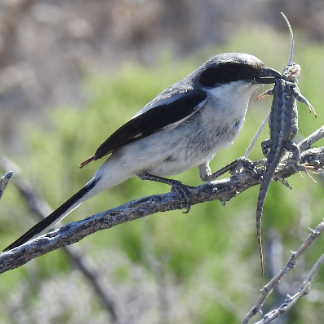Stopped By A Shrike
October 17, 2024

A Loggerhead Shrike with a Sagebrush
Lizard near Mono Lake, CA
A couple weeks ago I was walking through the Great Meadow scouting out a nature walk I was going to lead later that day. Suddenly, a medium-sized bird flushed out of one of the nearby shrubs, flew up the hill, and perched on another shrub right next to the bike path. As it flew, I caught distinct flashes of black, white, and gray. Through my binoculars, I could see it looking distinctly back in my direction from its new vantage. I could also plainly see that it was a bird I hadn’t seen on the campus in several years: a Loggerhead Shrike.
As I’ve only seen a shrike a handful of times in my 30-ish years here at UCSC, I stopped to watch it for a while. It was mid-morning and I was already sweltering in the full sun. But this bird seemed quite comfortable. I have mainly seen these birds in hotter, more arid parts of southern California. Maybe it welcomed the heat of the day? Eventually, perhaps seeing that I was no threat, it flew back down the hill and perched in a nearby shrub. Now I could easily see it’s dark black mask across the side of its face. I couldn’t help but smile, remembering the last time I’d seen one on campus was right here in this exact place!
I still remember one of my students unknowingly encountering a shrike about 15 years ago. As part of my “Natural History of UCSC” class, I had given her an assignment to go find a quiet “sit spot” somewhere in nature on the campus. Once there, she was supposed to sit down, quiet her mind, tune in to her senses, make observations and interpret what was going on around her, and record it in her field journal.
She found her quiet spot at the lower edge of the field below Oakes College. Soon after settling down, she got intrigued by a black, white, and gray bird that kept flying to and from a perch on the barbed wire fence in front of her. Eventually, something very peculiar happened. The next time it came back to the fence, it had a live lizard nearly as large as itself in its bill. It then proceeded to kill the lizard by spearing it on one of the fence barbs. Once pinned to the fence, it methodically tore the lizard into smaller pieces and ate it right in front of her. While grisly, it’s a pretty effective way to catch and consume prey that’s nearly as large as yourself!
Fulfilling her assignment, she captured the whole experience in words and sketches in her field journal, having no idea at the time what this bird was and that she had witnessed an event that very few people ever get to see.
At least one of those birds is back on our campus right now. And I bet the lizards in the Great Meadow know it!
Shrikes are widespread and in some places they’re pretty common. But not here. For me, it is always a thrill to see something rare on our campus.
It is also a relief. As someone who spends a considerable amount of my time paying attention to the “more than human world” around me, it’s hard not to worry. How will a rapidly warming planet or the impacts of the thousands of us who live and work on this hillside every day affect the rest of the life that lives here? Last week, as I stood there sweating in the hot sun, I could unequivocally conclude: for now at least, there is still room here for a few shrikes.
What a blessing that our campus still harbors incredible biodiversity: emerald green beetles, brilliant yellow mariposa lilies, glossy black salamanders, blue-tailed skinks, and so much more. But not everything withstands the changes. In the early 1990s right here in the Great Meadow, my wife observed (and recorded in her journal) a horned lizard. While found in other places in the Monterey Bay region, as far as I know, no one has seen one on the campus since.
Rare sightings aside, that shrike also offered me another kind of relief. For weeks – perhaps months – I had been constantly moving, doing, thinking, fretting, hardly pausing even to take a few slow breaths. And more recently, with the insanity that is our current national politics crescendoing all around me, words like hysterical, angry, and fearful were becoming increasingly more accurate descriptors of my emotional state.
Standing still watching that shrike gave me at least momentary reprieve from all of that. In that moment was only exhilaration, awe, and gratitude. It’s what I always hope will happen to my students when I give them the sit spot assignment. Unsurprisingly, the practice works for me too.
Slow down: The next day, on my bike ride up to campus, I stopped and sat down in the meadow for just a few minutes before continuing on to my office. Soon an American Kestrel, our smallest species of falcon, flew in and perched in the same shrub I’d seen the shrike in. I wondered what these two birds thought of one another.
Tune in to your senses: A few days later, again in the meadow, I paused and tuned in to the symphony of sounds around me. A faint shriek from across the meadow helped me see one, and then two Golden Eagles soaring in lazy circles above me.
Follow your curiosity: A week later, while walking under an oak tree, I kept hearing things falling from the top of the tree. It took several minutes to figure it out. A squirrel was nibbling acorns off the top branches and just letting them fall to the ground. Was it then going to climb down and collect them all? Either way, I thought the deer and the turkeys were probably appreciative!
These practices and many others provide space for me to think, reflect, heal, and escape the seemingly permanent frenzy of what author Jenny Odell calls the ‘attention economy’, including our social media platforms and the endless anxiety-inducing daily news cycles. In preparation for a talk I am going to give to the Kresge Core class later this month, I’ve been re-reading her book How To Do Nothing: Resisting the Attention Economy. For her and for me, watching birds (or squirrels) is an excellent way to “do nothing”.
Sometimes I wish I could fully escape into the natural world once and for all. But even if that were actually possible, I know I wouldn’t do it. As broken as the world seems most days, I still want to participate.
For me and for Odell, “it’s not a question of whether, but how.” The moments I take to stand apart from it all and marvel at the return of a shrike to our campus helps me let go of my anxiety and return to our public spaces with clarity, calm, and determination.
This fall, I have a shrike to thank for helping me find a little more sanity in our crazy world. With so much beauty and diversity outside our doors at UC Santa Cruz, I hope all of us can find a few moments to wander outside and stand in awe of the many "shrikes" still living around us. Chris Lay (Crown '95) teaches natural history classes and is the Administrative Director of the Ken Norris Center for Natural History at UC Santa Cruz.
Chris Lay (Crown '95) teaches natural history classes and is the Administrative Director of the Ken Norris Center for Natural History at UC Santa Cruz.
Fall is an exciting time to tune in to birds, as some species arrive and stay for the winter months and migratory species pop up for a few days as they make their way to their preferred wintering grounds. The appearance of a shrike is just one of several rare species that birders have been reporting in the Santa Cruz area in the last few weeks.
